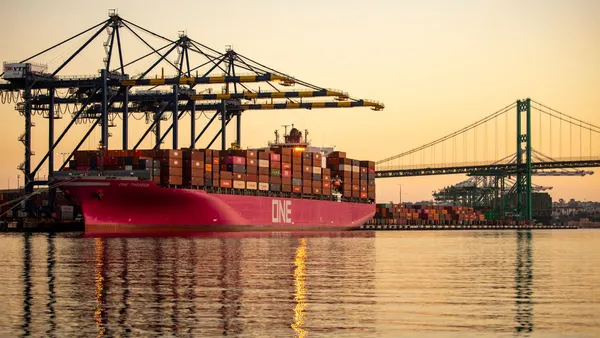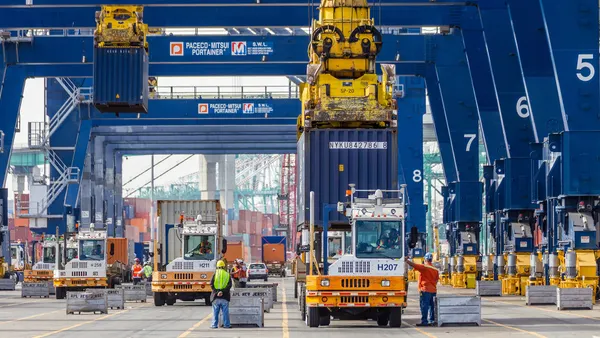Dive Brief:
- Ocean freight capacity dropped and rates rose around Golden Week at the beginning of October, providing little respite for shippers bringing in goods across the Transpacific.
- Transpacific rates were $16,153 per FEU from Asia-U.S. West Coast and $18,711 from Asia-U.S. East Coast during week 39, a week before Golden week. By week 41, a week after Golden Week, rates had increased to $17,377 per FEU from Asia-U.S. West Coast and $20,695 from Asia-U.S. East Coast, according to Freightos.
- Asia to North America capacity growth dropped from 30.8% to 25.1% YoY during Golden Week, but remained at the highest level compared to the 2015-2020 analyzed period, according to Sea-Intelligence’s Sunday Spotlight Issue 534.
Golden Week's effects on the market in 2021
| Metric | Effect |
|---|---|
| Capacity | Carriers are increasing capacity by 37.9% more compared to Q3 peak cargo season. An unprecedented level that shows carriers expect the peak season to also extend to Q4, according to Sea-Intelligence. |
| Rates | Transpacific rates were $16,153 per FEU from Asia-U.S. West Coast and $18,711 from Asia-U.S. East Coast during week 39, a week before Golden week. By week 41, a week after Golden Week, rates had increased to $17,377 per FEU from Asia-U.S. West Coast and $20,695 from Asia-U.S. East Coast, according to Freightos. |
| Canceled sailings | For weeks 43 through 46, 41 canceled sailings were announced out of 535 scheduled sailings, an 8% cancellation rate, according to Drewry. |
Dive Insight:
Typically, Golden Week signals the end of peak season for ocean shipping. But in the weeks following, the current supply chain environment has prevented shippers from experiencing any kind of relief from the slowdown the holiday week tends to bring.
"This year, it is a very different market from anything we’ve seen in the past; mostly due to the extreme demand for space over the past 6-months," said Peter Aaro-Hansen, chief commercial officer at Green Worldwide Shipping. "We are not feeling the impact of Golden Week nearly as much because the pressure has been on U.S. supply chains for quite some time."
Factories typically shut down and production slows around Golden Week. This year, those issues were magnified as businesses rushed to have product delivered before the holiday season. Toymakers raised concerns of products making it onto shelves, which is why some retailers stocked up early to be well positioned for the holidays.
The present ocean delays make it "increasingly unlikely that shipments not already moving will make it in time for the holidays," according to a Freightos analysis.
But this year, something else was different about Golden Week. Power restrictions mandated by China added to the production slowdowns.
The lack of manufacturing during the holiday week "could have relieved some pressure on the ports and given them time to catch up," Judah Levine, head of research at Freightos, said in an email. Volumes dipped at the Port of Los Angeles during week 40 (Golden Week), before rebounding to more than double during week 41.
Sri Laxmana, vice president of global ocean services at C.H. Robinson, added the tapered demand is "not enough to make a significant dent in relieving the current congested ports."
While there is no clear indication on when supply chain will ease back to pre-pandemic times, C.H. Robinson and the shippers it works with are looking for creative solutions to get products to the U.S.
"For our customers, we’re leveraging every available ocean port, different shipping options like but not limited to less-than-container-load (LCL), different air routings or air charters when needed, as well as inland expedited solutions," said Laxmana.













